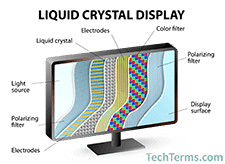LCD
Stands for "Liquid Crystal Display." LCD is a flat panel display technology commonly used in TVs and computer monitors. It is also used in screens for mobile devices, such as laptops, tablets, and smartphones.
LCD displays don't just look different than bulky CRT monitors, the way they operate is significantly different as well. Instead of firing electrons at a glass screen, an LCD has a backlight that provides light to individual pixels arranged in a rectangular grid. Each pixel has a red, green, and blue RGB sub-pixel that can be turned on or off. When all of a pixel's sub-pixels are turned off, it appears black. When all the sub-pixels are turned on 100%, it appears white. By adjusting the individual levels of red, green, and blue light, millions of color combinations are possible.
How an LCD works
The backlight in a liquid crystal display provides an even light source behind the screen. This light is polarized, meaning only half of the light shines through to the liquid crystal layer. The liquid crystals are made up of a part solid, part liquid substance that can be "twisted" by applying electrical voltage to them. They block the polarized light when they are off, but reflect red, green, or blue light when activated.
Each LCD screen contains a matrix of pixels that display the image on the screen. Early LCDs had passive-matrix screens, which controlled individual pixels by sending a charge to their row and column. Since a limited number of electrical charges could be sent each second, passive-matrix screens were known for appearing blurry when images moved quickly on the screen. Modern LCDs typically use active-matrix technology, which contain thin-film transistors, or TFTs. These transistors include capacitors that enable individual pixels to "actively" retain their charge. Therefore, active-matrix LCDs are more efficient and appear more responsive than passive-matrix displays.
NOTE: An LCD's backlight may either be a traditional bulb or LED light. An "LED display" is simply an LCD screen with an LED backlight. This is different than an OLED display, which lights up individual LEDs for each pixel. While the liquid crystals block most of an LCD's backlight when they are off, some of the light may still shine through (which might be noticeable in a dark room). Therefore OLEDs typically have darker black levels than LCDs.
 Test Your Knowledge
Test Your Knowledge
